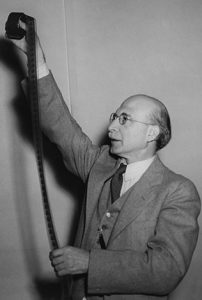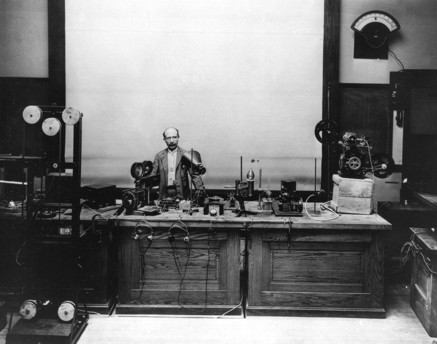Previous Communication Tour Stop | Return to Communication Tour Map | Next Communication Tour Stop
Previous “Fine…” Tour Stop | Return to “Fine…” Tour Map
Return to Bardeen Quad Tour Map | Next Bardeen Quad Tour Stop

Joseph Tykochinski-Tykociner was born into a merchant family in Vloclawek, Poland on October 5, 1877. Tykociner left Europe in 1896, at the age of 18, and traveled to the United States in hopes of developing his idea of electronically recording sound on film. When he arrived in the United States he found employment in New York, at the Electric Car Lighting Company constructing lightweight batteries. He then jumped from job to job while attending night classes at Cooper Union. In 1897, he returned to Europe to continue his studies in electrical engineering at the Höheres Technisches Institut in Köthen, Germany. As a young adult he first went to work for Marconi Wireless Telegraph Company in London, which, in 1901, was the first radio company to broadcast overseas. He left the Marconi Company and went to work for Telefunken in Berlin. In 1904 he was asked by the Russian Czar to establish a radio link for the Russian naval fleets between the Baltic and Black sea.

Note: demonstration starts at 5:16
– Materials Science and Engineering Building. Formerly the Physics Building, this is where Tykociner held a public demonstration of sound on film.
Joseph Tykociner and Sound Motion Picture Demonstration. (1922, June 9). Joseph T. Tykociner Papers 1900-69. Record Series 11/6/20, Box 10, folder 1920-69. University of Illinois Archives.
Joseph Tykociner Looks at a Film Reel. (1949, Oct. 5). Joseph T. Tykociner Papers 1900-69. Record Series 11/6/20, Box 10, Folder Photos – Tykociner C.1920-1969. University of Illinois Archives.
Kingery, R. A., Berg, R. D., & Schillinger, E. H. (1967). Men and Ideas in Engineering. Urbana, IL: University of Illinois Press
Newsclipping about Joseph Tykociner and Sound on Film. (1922, July 30). Joseph T. Tykociner Papers, 1900-69. Record Series 11/6/20, Box 12, Folder 1900-22. University of Illinois Archives.
Zielona, S. O. (2006). “Contributions of Polish Jews: Joseph Tykocinski-Tykociner (1877-1969), Pioneer of Sound on Film.” Academia.edu. AAPJS Gazeta, Vol.13, no. 3. Retrieved 30 Sept. 2014 from https://www.academia.edu/people/search?utf8=%E2%9C%93&q=Joseph+Tykoci%18ski%E2%80%93Tykociner.
